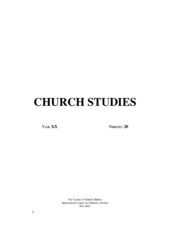Приказ основних података о документу
Краљица Јелена у улози мајке
Queen Helen in the role of a mother
| dc.creator | Митровић, Катарина С. | |
| dc.date.accessioned | 2023-09-04T08:49:22Z | |
| dc.date.available | 2023-09-04T08:49:22Z | |
| dc.date.issued | 2023 | |
| dc.identifier.issn | 1820-2446 | |
| dc.identifier.issn | e2738-1633 | |
| dc.identifier.uri | http://reff.f.bg.ac.rs/handle/123456789/4784 | |
| dc.description.abstract | У овом раду пажња је усмерена на приватни и породични живот краљице Јелене, с посебним освртом на њене односе са синовима краљевима – Драгутином и Милутином, ћерком Брњачом, снахама Каталином и Симонидом, унукама Катарином и Маргаритом, као и другим појединцима и мањим групама људи који су је могли доживљавати као мајчинску фигуру. Потенцијално веродостојна реконструкција краљичине личности из улоге мајке извршена је на основу података садржаних у житијима из пера архиепископа Данила Другог, сведочанставима Теодора Метохита и других византијских писаца, повељи за Ратачку опатију, преписци с Апостолском столицом, ктиторским натписима и ликовним представама. Изворни подаци тумачени су у кључу дубинске психологије, архетипова мајке Карла Густава Јунга и трансакционе анализе као теорије о развоју понашања. | sr |
| dc.description.abstract | This paper considers the personality of Queen Helen (around 1250–1314) as a mother. The main topic is her relationship with her sons, King Stefan Dragutin (1276–1282) and King Stefan Uroš II Milutin (1282–1321). Her sons had deep respect and loyalty to their mother, and her authority was rooted in the personal traits that mostly mirrored the virtues expected from a model of Christian female ruler like wisdom, social graces, modesty, charitability and protectiveness of the family, clergy and religious institutions as well as people in need because of old age, illness, poverty. Relations with the female members of the family were also studied: with her daughter Brnjača, daughters-in-law Queen Consorts Katalina and Simonida and granddaughters Katarina and Margarita. All relations in which Queen Helen may have been seen as a mother figure by other individuals or small groups were also taken into consideration, like the monastic family and builders who constructed her bequest monastery of Gradac dedicated to celebration of Annunciation or members of marginalized groups referred to in different sources as widows, destitute girls, the lame, ill, blind or the poor. All sources were studied that provide information relevant to the paper topic: Life of Queen Helen written by her close associate, archbishop Danilo II; writings of Theodore Metochites and other Byzantine authors; Charter for the Benedictine Abbey of St. Mary of Ratac near Bar; correspondence with the Apostolic See, mainly Pope Nicholas IV; donor inscriptions on the Benedictine Church at the Monastery of St. Sergius and Bacchus on the Bojana River; as well as artistic renderings (frescos and icons) and inscriptions on them. The collected data are interpreted in the key of the depth psychology, mother archetypes of Carl Gustav Jung and the transaction analysis as a theory of communication. Reconstruction was thus rendered of a potentially probable personality of Queen Helen, taken from one of the primary roles in her life. | sr |
| dc.language.iso | sr | sr |
| dc.publisher | Центар за црквене студије, Ниш | sr |
| dc.relation | info:eu-repo/grantAgreement/MESTD/inst-2020/200163/RS// | sr |
| dc.rights | openAccess | sr |
| dc.rights.uri | https://creativecommons.org/licenses/by/4.0/ | |
| dc.source | Црквене студије | sr |
| dc.subject | краљица Јелена | sr |
| dc.subject | архиепископ Данило Други | sr |
| dc.subject | краљ Драгутин | sr |
| dc.subject | краљ Милутин | sr |
| dc.subject | принцеза Брњача | sr |
| dc.subject | мајчинство | sr |
| dc.title | Краљица Јелена у улози мајке | sr |
| dc.title | Queen Helen in the role of a mother | sr |
| dc.type | article | sr |
| dc.rights.license | BY | sr |
| dc.citation.epage | 366 | |
| dc.citation.rank | M23~ | |
| dc.citation.spage | 349 | |
| dc.citation.volume | 20 | |
| dc.identifier.doi | 10.18485/ccs_cs.2023.20.20.21 | |
| dc.identifier.fulltext | http://reff.f.bg.ac.rs/bitstream/id/11745/bitstream_11745.pdf | |
| dc.type.version | publishedVersion | sr |

